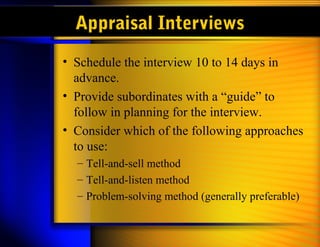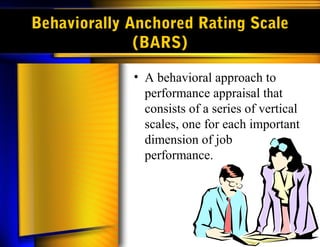HRM complete Course
- 2. Performers Appraisal Learning Objectives • Explain Purposes of Performance Management • Identify Success Factors in Good Programs • Identify Sources of Information for Evaluation • Explain Key Methods used in Managing Performance • Outline the Manager/Sub-Ordinate Interview
- 3. Purpose of Performance Appraisal Systems • Goal: Maintain Organizational Productivity • Results: Organization Productivity Individual Performance • Methods: Individual Performance Goals
- 4. Objectives • Opportunity to Regularly Discuss Results • Supervisor Identifies Strengths and Weaknesses • Fair and Equitable Format • Basis for Salary/Promotion Recommendations
- 5. Main Purposes of Performance Management • Individual Rewards (Base and Incentive) • Feedback for Sub-Ordinate (Plus and Minus) • Recognition of Superior Performance • Documentation of Weak Performance • Personnel Decision-Making • Future Goal Commitments (Planned Achievements)
- 6. Reasons for Appraisals • Compensation "Pay for Performance" • Job Performance Improvements • Feedback to Subordinates • Documentation for Decisions • Goal Setting - Later Evaluation • Promotion Decisions • Identify Training Needs • HR Planning
- 7. Primary Uses of Performance Appraisals Small Organizations Large Organizations All Organizations Compensation 80.2% 66.7% 74.9% Performance improvement 46.3% 53.3% 48.4% Feedback 40.3% 40.6% 40.4% Documentation 29.0% 32.2% 30.2% Promotion 26.1% 22.8% 24.8% Training 5.1% 9.4% 7.3% Transfer 8.1% 6.1% 7.3% Discharge 4.9% 6.7% 5.6% Layoff 2.1% 2.8% 2.4% Personnel research 1.8% 2.8% 2.2% Manpower planning 0.7% 2.8% 1.5%
- 8. Trends in Managing Performance Superior Performance leads to Superior Rewards Issue: How to objectively measure specific goals! Appraising/Evaluating Managing Performance VERSUS
- 9. Who Performs the Appraisal? • Immediate Supervisor • Higher Management • Self-Appraisals • Peers (Co-Workers) • Evaluation Teams • Customers • “360° Appraisals”
- 10. Supervisor Appraisal • Performance appraisal done by an employee’s manager and often reviewed by a manager one level higher.
- 11. Self-Appraisal • Performance appraisal done by the employee being evaluated, generally on an appraisal form completed by the employee prior to the performance review.
- 12. Subordinate Appraisal • Performance appraisal of a superior by an employee, which is more appropriate for developmental than for administrative purposes.
- 13. Peer Appraisal • Performance appraisal done by one’s fellow employees, generally on forms that are complied into a single profile for use in the performance interview conducted by the employee’s manager.
- 14. Team Appraisal • Performance appraisal, based on TQM concepts, that recognizes team accomplishment rather than individual performance.
- 15. The 360º Appraisal Interview Individual Staff Self-Assessment Supervisor Other Superiors Peers Teams Sub-Ordinates Teams Customers Other Superiors
- 16. Performance Appraisal Problems • Popularity Contest • Punitive Implications • Control Relinquishment • Stereotypes • Poor Training of Raters
- 17. Peer Appraisal Concerns • Disadvantages? • Advantages?
- 18. Rating Errors Issues • Carefully Developed Behavior Descriptions Fair • Evaluation Scales • Factor Relatedness to the Job
- 19. Types of Rating Errors • Leniency/Strictness Error • Define Anchors (Dimensions) • Force A Curve • Central Tendency • Reluctant to Give High/Low • Explain Need for Variability • Recency Error • Last Action Halo • Encourage Frequent Evaluation
- 20. Error of Central Tendency • Performance-rating error in which all employees are rated about average.
- 21. Leniency or Strictness Error • Performance-rating error in which the appraiser tends to give employees either unusually high or unusually low ratings.
- 22. Recency Error • Performance-rating error in which the appraisal is based largely on the employee’s most recent behavior rather than on behavior throughout the appraisal period.
- 23. Rating Errors Example Halo Job Rating Scale EXCELLENT on all factors Leniency Job Rating Scale Employee A EXCELLENT Job Rating Scale Employee B EXCELLENT Job Rating Scale Employee C SUPERIOR Job Rating Scale Employee D EXCELLENT Central Tendency Job Rating Scale Employee A AVERAGE Job Rating Scale Employee B AVERAGE Job Rating Scale Employee C AVERAGE Job Rating Scale Employee D AVERAGE Recency Bias Job rating scale behavior during the last month has been POOR.
- 24. Similar-To-Me Error • Performance-rating error in which an appraiser inflates the evaluation of an employee because of a mutual personal connection.
- 25. Appraisal Training Programs Needs 1. Explain Objectives 2. Review the Instrument 3. Define the Performance Standards 4. Understand Typical Subjective Errors 5. Teach Interviewing Skills
- 26. Scheduling the Performance Appraisal 1. Schedule the review and notify the employee ten days or two weeks in advance. 2. Ask the employee to prepare for the session by reviewing his or her performance, job objectives, and development goals. 3. Clearly state that this will be the formal annual performance appraisal.
- 27. Preparing for the Review for the Performance Appraisal 1. Review the performance documentation collected throughout the year. Concentrate on work patterns that have developed. 2. Be prepared to give specific examples of above- or below-average performance. 3. When performance falls short of expectations, determine what changes need to be made. If performance meets or exceeds expectations, discuss this and plan how to reinforce it. 4. After the appraisal is written, set it aside for a few days and then review it again. 5. Follow whatever steps are required by your organization’s performance appraisal system.
- 28. Appraisal Interviews • Schedule the interview 10 to 14 days in advance. • Provide subordinates with a “guide” to follow in planning for the interview. • Consider which of the following approaches to use: – Tell-and-sell method – Tell-and-listen method – Problem-solving method (generally preferable)
- 29. Tell-and-Sell Interviews 1. Supervisor persuades employee to change in a prescribed way. 2. Employees sees how changed behavior will be of great benefit.
- 30. Tell-and-Listen Interviews 1. Supervisor covers strengths/weaknesses for first half 2. Solicits employee’s feelings about comments 3. Deal with disagreement, non-defensively 4. Negotiate future concrete objectives
- 31. The Problem Solving Interview 1. Discuss strengths and weaknesses since last review 2. Explore feelings of sub-ordinate 3. Listening, accepting, and responding are essential 4. Stimulate growth (performance) job 5. Discuss problems, needs, innovations, satisfactions and dissatisfactions since last review 6. Listen and respond with goal of helping person and productivity.
- 32. Appraisal Interviews • During the Interview: – Emphasize strengths to build on. – Suggest more acceptable ways of acting. – Concentrate on present opportunities for growth. • Techniques: – Listen more than you talk. – Use a variety of types of questions. – Avoid the sandwich technique.
- 33. Establishing Job Related Performance Standards 1. Relevant 2. Free From Contamination 3. Reliable - Inter Rater Consistency
- 34. Appraisal Program Failure Concerns 1. Little Benefit Relative to Time Commitment 2. Face to Face Confrontation 3. Unskilled Appraisers 4. Role Conflict: Judge or Teacher
- 35. Appraisal Methods • Rating Scales • Essay • Management by Objectives • Check Lists by Key Words • Forced Choice Statements • Ranking of Employees
- 36. Rating Scale Methods (most popular) (Check each trait being evaluated) 1. Global Scale (Total Performance) 2. Mixed Standard Scale (Choose from Different Statements) 3. Behaviorally Anchored Rating Scale (Descriptions along the scale to define)
- 37. Behaviorally Anchored Rating Scale (BARS) • A behavioral approach to performance appraisal that consists of a series of vertical scales, one for each important dimension of job performance.
- 39. Graphic Rating-Scale Method • Performance appraisal whereby each employee is rated according to a scale of pre-defined characteristics that are job performance related.
- 41. Forced-Choice Method • A trait approach to performance appraisal that requires the rater to choose from statements designed to distinguish between successful and unsuccessful performance.
- 42. Essay Method • A trait approach to performance appraisal that requires the rater to compose a statement describing employee behavior.
- 43. Essay Method • Write a Behavioral Statement • Strengths versus Weaknesses • Describe Selected Traits • Evaluate Performance Advantages Disadvantages
- 46. Critical Incident • Unusual event that denotes superior or inferior employee performance in some part of the job.
- 47. Management By Objective (MBO) • Philosophy of management that rates performance on the basis of employee achievement of goals set by mutual agreement of employee and manager.
- 48. Management by Objectives (Peter Drucker) • Integrates performance and goal setting • Frequent intervals • Record maintenance • Objective review jointly • Mutual buy-in
- 49. Advantages of MBO • Employees Can Measure Performance • Quantifiable Goals • Joint Effort • Employee Satisfaction in Participation
- 50. Disadvantages of MBO • Success Not Validates by Research Studies • Easy to Set Unrealistic Goals • Hard to Get Full Commitment to Process • Difficult to Define Some Goals
- 51. Performance Appraisal Interview Needs • Trained Interview Techniques • Honesty in Appraisal • Well Planned Structure • Carefully Conducted • Feedback Openness • Adequate Time (more than one session occasionally)
- 52. Procedural Guidelines 1. Listen More Than Talk (1/3 rule) 2. Vary the Questions (Open ended/elaboration) 3. Follow-up Questions (force through responses) 4. Reflect Feelings (clarify-sincerity) 5. Avoid Sandwich Technique (Positive-Negative- Positive) • Why? Signals Bad News • No More Bad News • Discourages Real Communication
- 53. Measuring Performance Final review of subordinate results measured against esta-blished or revised goals Periodic review periods providing feedback on interim results measured against established goals Joint agreement on subordinate goals and measures Department-specific goals Measures of department performance Organization’s common goals Measures of organization performance Supervisor lists goals and measures for subordinate Subordinate proposes goals and measures for his or her job New inputs provided Inappropriate goals eliminated
- 54. Performance Appraisal • Amoco Performance Management –Description –Process –Developing –Reviewing –Pay Decision –Skills Assessment –Appraisal
- 55. Performance Appraisal Examples Performance Appraisal Form Performance Management Form Self-Evaluation Critical Success Factors Professional Staff Evaluation Proce
























































